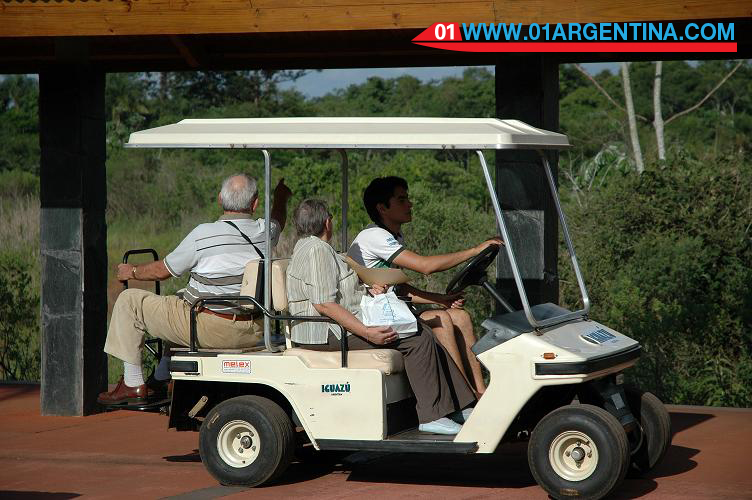
To be within the qualification of the Architecture without Barriers program, the National Parks Administration has eliminated all the architectural elements that prevent the normal displacement of children and people with some type of disability and intervened with an emphasis on saving the different barriers that are found In a traditional architecture.
A person who moves in a wheelchair can travel all the facilities, walks and services in Iguazu National Park without any inconvenience since descending from the vehicle that transports him to the park, until he retires from it.
The building.
• All pavements in the Cataratas Area were built to make wheelchairs and walking for people with visual impairment safe.
• All buildings that make up the concession area have access by means of ramps, as well as in walkways or places where the unevenness requires it. The buildings have the same floor, with the same texture, in rooms as well as in toilets: granite polished to lead in the interiors, the exteriors are brushed concrete and metallic grating catwalks.
• There are toilets in all sectors of the park, in the access, in the train stations, in Restaurant La Selva and in the food court. The width of its doors allows the entrance of users of wheelchairs.
• The surface of the baths allows the entrance and the rotation of wheelchairs, and they have supports to both sides of the same one. The washbasins allow a person in a wheelchair to wash their hands comfortably. It has urinals at a lower height for people of low size.
The Circuits.
• Railings with double wooden handrails have been placed on all walkways in the park for the safety of children and persons with disabilities who move through the use of wheelchairs. A protective profile has been placed at the bottom of the gangways, and on both sides, a metal profile for protection of wheelchairs and baby strollers. The artistic wire is a closure for protection of children.
• All walkways are 120 centimeters wide when they are one-way and 180 centimeters when they are back and forth. There are no pending more than 6%.
• Access to the gateway to the Devil’s Throat is accessible, as is 100% of its extension.
• The entrance to the Superior Circuit is accessible, and so is 100% of its route.
• Access to the Lower Circuit is practicable for people who use wheelchairs, it can be done through ramps or stairs. If it is done with wheelchairs you can choose to go in an electric vehicle (golf type) to the Dos Hermanas square, from there you continue in the wheelchair through ramps, you access 90% of that circuit.
• The Green Path is accessible, has no obstacles, has smooth slopes. It enjoys optimal conditions for the circulation, as for its road and the absence of lateral obstacles. In the middle extends a short bridge, installed with the same material of the catwalks. At the end of the route, the visitor will find a small barrier that anticipates the crossing of the tracks of the Ecological Train of the Jungle. Meters later, it is acceded by a cement sidewalk, to the platform of the Falls Station.
Transport in Iguazu
• The Jungle Ecological Train, powered by Liquefied Petroleum Gas (LPG) has an exclusive design for the Iguazú National Park. In each car there are places destined to the wheelchairs, in which the seats are rebatted. Its floor is aluminum with melon seeds texture in order to be non-slip.
• For people with disabilities and others who can not move on their own, there are small motor vehicles that can carry them through the different sectors of the park. One is at the entrance of the park, to avoid walking the 400 meters to the Central Train Station, and the other at the Cataratas Station, to approach the entrance of the Upper and Lower Circuits.
• There are wheelchairs, specially adapted to the catwalks, in the Stations Cataratas and Garganta del Diablo and in places of numerous influx of visitors. Both these, and small motor vehicles, are free to use.
Argentina sums destinations prepared for the tourism of people with diverse capacities, but the advances arrive at a slower pace than the one wanted, according to coincide people in charge of public institutions and private companies.
The major drawbacks are the integration of the whole service chain for people with limited mobility, suitable for wheelchairs, baby strollers or for the blind or deaf, for example.
Puerto Madryn is one of the most complete cases in the country. The destination, which is internationally attractive especially for whale watching, has adapted accommodations, spas with access ramps, integrated excursions and accessible taxis. “They solved one of the biggest drawbacks, which is mobility and that usually causes the chain to break,” explains Miguel Tacconi, one of the people responsible for the Via Accessible portal, with information on the existing offer.
“More and more progress has been made in several provinces, thanks to the greater responsibility and sensitivity and also because we start to see that it is an interesting economic niche,” says Tacconi. The site was born on his initiative and Diego Jorge, both lovers of travel and mobility problems. “From our need we began to search and found nothing.”
About 10% of the population has special accessibility needs. Iguazu National Park was the first in the country to integrate; Followed by Talampaya in La Rioja. In Los Glaciares (Santa Cruz) there is an accessible walkway; The Train of the End of the World, in Ushuaia, is also adapted.









